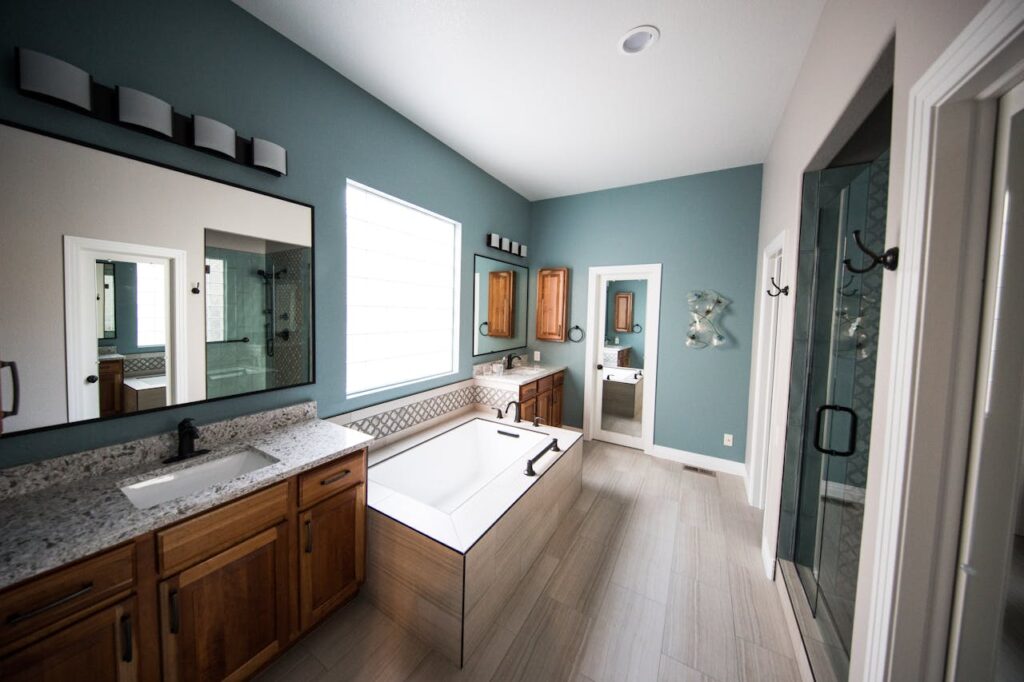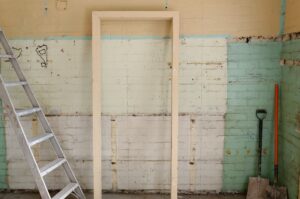
Chris Town Here, Owner Of Town Construction And Development Here With Some More Great Tips:
Moving a Shoreline bathroom to another room.
Moving a bathroom to another room in your home isn’t just a matter of shifting fixtures. It requires careful planning, a clear understanding of your space, and a realistic budget. Whether seeking more convenience or upgrading your home’s layout, this significant alteration needs a solid strategy. We’re here to guide you through this process, offering practical advice and essential considerations to help you manage this change efficiently. Bear in mind that bathroom remodeling and moving involve more than just aesthetics. It’s all about creating a functional space that meets your needs.
Planning and Design: Space, Layout, and Budget
Planning your bathroom move starts with a clear vision. Think about why you’re moving the bathroom. Is it for more comfort, better space utilization, or accessibility? Your goals shape the design and layout. First, measure your available space. Is the new area large enough for a bathroom? Consider the room’s shape and how your fixtures will fit. This isn’t just about squeezing everything in; it’s about creating a functional layout. Designing the layout involves more than the visual aspect. It’s about practicality. Where will the shower, sink, and toilet go? How will the door open without clashing with fixtures? Answering these questions helps create a bathroom that’s both beautiful and practical.
In addition, budget is crucial. Moving a bathroom to another room can be costly—factor in expenses like plumbing, electrical work, fixtures, and finishes. Don’t forget labor costs. A detailed budget keeps you grounded and prevents costly surprises. Also, if you want budget-friendly ways to tackle this, think about whether it’s worth moving it after all. This stage sets the foundation for your project. Take your time, think it through, and get it right.
Moving your bathroom to another room means not just one complete redo but actually two.
Understanding and Managing Plumbing and Electrical Needs
Moving a bathroom involves more than relocating fixtures. It’s a complex task, especially when considering plumbing and electrical systems. For starters, understand the plumbing. This includes water supply and waste lines. Where are your current pipes located? How will they connect to the new bathroom? You might need to extend or reroute them. This is a job for professionals – a plumber’s expertise is crucial to prevent leaks and ensure proper water flow.
Next, think about the electrical setup. Bathrooms need safe, properly placed outlets and, often, dedicated circuits. Lighting is another crucial aspect. Your electrician will ensure all wiring is up to code and safely installed, vital in a moisture-prone bathroom. Ultimately, it’s about ensuring everything works safely and efficiently behind the walls.
Choosing Materials and Contractors when Moving a Bathroom to Another Room
When taking on such a lengthy renovation process, selecting the right materials and contractors is the foundation for a successful outcome. Choosing materials is about balance. You need items that are not only visually appealing but also durable. For flooring, though wood might be in style, consider moisture resistance. Tiles work well, but there are various types. Opt for non-slip, water-resistant tiles like ceramic or porcelain. These materials resist moisture and are easy to clean.
Walls and countertops also require materials that can handle humidity. Consider moisture-resistant paint or tiles. They prevent mold growth and are easy to maintain. When it comes to countertops, materials like quartz or granite are durable and resist water damage. For fixtures, choose stainless steel or brass for faucets and showerheads for longevity. Remember, quality matters. It ensures your new bathroom stays in top condition for longer.
Importantly, select a reliable contractor. Look for skilled professionals with experience in bathroom renovations. Check their references and previous work. A trustworthy company or person will save you time and reduce stress. They ensure the job is done right, from plumbing to electrical work.
Materials should always be in harmony with the rest of the house, and there are ways to include delicate elements in your aesthetics.
Navigating Permits, Regulations, and the Renovation Process
Relocating a bathroom isn’t just about the physical work; it also involves navigating the legal landscape. Before starting, check your local building regulations. Obtaining the necessary permits ensures your project complies with safety and building codes. These permits are often required for significant changes like plumbing and electrical work. What’s more, your renovation must adhere to local building codes. These regulations cover everything from ventilation to electrical outlet placement. Following these rules is crucial for safety and legal compliance.
Once you begin, prepare for some disruption. Effective communication with your contractor can help manage the process smoothly. Regular progress checks are essential to stay on schedule and address any issues promptly. Furthermore, living in a house while a bathroom remodel takes place requires patience and planning. Set up a temporary bathroom space, if possible, to minimize inconvenience. Expect some noise and disruption, and keep communication open with the contractors to stay informed about the progress and any schedule changes. Protect your belongings from dust and debris, and maintain a flexible mindset. It’s a short-term hassle for a long-term improvement in your home.
While it might be tempting to do most of the work yourself, you should always seek professional help for such a task.
Preparing for Challenges and Unexpected Issues
While embarking on a bathroom move process, anticipating and handling unexpected challenges is essential for a smooth undertaking. Be prepared for unforeseen issues like plumbing complexities or structural surprises once walls are opened. It’s common in renovations, especially in older homes. During construction, your usual routines will be disrupted. You might need to move fixtures or personal items. Or you might even need temporary storage. Here, a moving company like spydermoving.com can be a lifesaver. They ensure your belongings are safely relocated or kept, making room for the work and reducing stress.
However, overall, keep an open mind and be ready to adjust plans. If a challenge arises, discuss alternatives with your contractor. Additionally, ask them to keep you informed about progress and any unexpected findings. This way, you can make informed decisions quickly. Also, have a contingency plan, including a budget buffer, typically an additional 10-15% of your total budget. This helps cover unforeseen expenses without derailing your project. Flexibility can lead to creative solutions that may even improve the final outcome. Anticipating these hurdles and having a plan to tackle them will help you navigate the renovation journey more smoothly.
Wrap-up
Moving a bathroom to another room is a significant undertaking, but it can transform your home with the right approach. Careful planning, understanding technical needs, choosing the right materials and contractors, adhering to regulations, and preparing for unexpected challenges are key in this journey. Each step is important in shaping a functional and appealing new bathroom space. While this project might seem daunting, remember the end result—a beautifully remodeled bathroom tailored to your needs.



